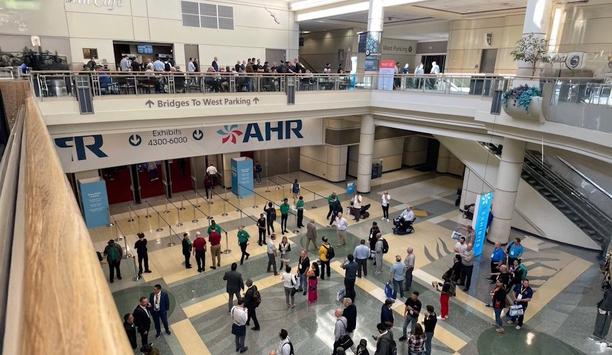Now, more than ever, Indoor Air Quality (IAQ) is a major focus concerning the health and safety of students and faculty within the nation’s schools. As they prepare their facilities for a return to in-person learning, school officials are being forced to get an education in the most effective ventilation solutions to help prevent the spread of COVID-19 and other infections.
Even without factoring in airborne threats like COVID-19, poor IAQ can negatively affect the health and learning of students. According to the U.S. Environmental Protection Agency, the presence of dampness and mold increases the risk of asthma and other respiratory diseases by 30-50%, and that students in well-ventilated classrooms tend to achieve higher scores on standardized tests than children in poorly-ventilated classrooms.
Ventilation Improvements
Guidance from the U.S. Centers for Disease Control indicates that ventilation system improvements can increase the delivery of clean air and dilute potential contaminants. The World Health Organization (WHO) also emphasizes the important role that HVAC improvements can play in keeping people safe indoors: Use of Dedicated Outdoor Air Systems (DOAS) is one option to improve ventilation and IAQ
"A well-maintained and operating system can reduce the spread of COVID-19 in indoor spaces by increasing the rate of air change, reducing air recirculation, and increasing the amount of outdoor air coming in. Settings that recirculate the air should not be used. HVAC systems should always be regularly inspected, maintained, and cleaned."
One option to improve ventilation and IAQ that is growing in popularity is the use of Dedicated Outdoor Air Systems (DOAS). These units can process high volumes of fresh outside air, tempering and dehumidifying it to avoid putting an excessive load on the facility’s cooling and heating systems.
Conditioning Air
The introduction of large volumes of outside air does create some extra challenges. The process to condition the air can be energy-intensive if the conditions outside are especially hot, cold, dry, or humid. That’s led to the development of energy recovery devices, usually a plate heat exchanger or heat recovery wheel that can be used to offset the power demand of the HVAC system.
The devices work by capturing energy from the previously conditioned relief air as it is expelled from the facility. The devices are typically 60% efficient allowing for a significant amount of energy can be saved. This makes the improved ventilation a far more cost-effective proposition and reduces the size of the mechanical systems needed to serve the space.
Other Steps to Take
In addition to increasing the ventilate rate in classrooms, facilities managers can take other steps to improve the IAQ in schools:
- Better filtration. Because of increased concern about pathogens, MERV 13-and-higher filters are increasingly being used in schools instead of the traditional MERV 8. The higher-rated filters are able to filter out much smaller particles, but there is a trade-off. Their usage leads to a greater indoor pressure drop than normal. This is being addressed on the manufacturer level with the increased use of electronically commutated motors within HVAC systems.
- Active neutralization. The CDC recommends ultraviolet germicidal irradiation (UVGI) applications as a supplementary measure to improve IAQ within schools.
- Control dehumidification. There is a growing use of dedicated humidity control systems in facilities outside of the humid southern states. Humidity control units can dehumidify indoor air while maintaining comfortable room temperatures.
- Proper maintenance. When considering IAQ issues affecting schools, lack of proper maintenance of HVAC equipment can have tangible effects on the quality of life of students. According to the EPA, those schools without major maintenance backlogs have a higher average daily attendance (ADA) by an average of 4 to 5 students per 1,000 as well as a lower annual dropout rate by 10 to 13 students per 1,000.
School Funding Opportunities
As school systems across the U.S. evaluate the state of their HVAC systems, many will have to reckon with the need to meet modern codes and standards. Older buildings can require substantial improvements to their HVAC systems, so it is to be expected that this will be an ongoing concern. American Rescue Plan includes $130 billion in funding that school systems can also use to improve ventilation systems
To lower financial barriers for schools, there are new federal funding opportunities to help local school systems improve classroom ventilation. The American Rescue Plan includes $130 billion in funding dedicated to K-12 education that school systems can also use to improve ventilation systems in their facilities. This joins the $54.3 billion that the U.S.
Congress approved for the Elementary and Secondary School Emergency Relief Fund (ESSER II Fund) in 2020 to allow school systems to address “preparing schools for reopening, and testing, repairing, and upgrading projects to improve air quality in school buildings.”
Innovation and Quest For Improvement
The federal funding can provide the opportunity for a fresh start for schools, allowing them to upgrade their HVAC systems to meet modern standards. These standards continue to evolve and new metrics such as the Integrated Seasonal Moisture Removal Efficiency (ISMRE) will continue to be developed. The ISMRE has been incorporated into ASHRAE 90.1 as part of a measure to set minimum energy efficiency standards for DOAS applications.
Thanks to the industry’s ongoing innovation and quest for improvement, there is an array of critical HVAC tools available that schools can use to protect the health, safety, and quality of life of students in the classroom. Upgrading school ventilation systems is the pathway to creating the comfortable, safe learning environments that all students deserve.
Now with federal funding available, school systems have a better opportunity to update their heating and cooling systems to improve air quality while benefiting from reduced operational costs due to meeting modern efficiency standards.



















